Wondering who wins the race between two popular types of self-balancing scooters – hoverboards and Segways?
We’re here to see how they compare and which will suit you best!
Hoverboards
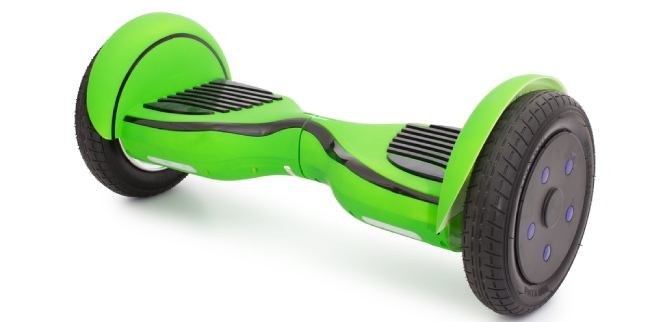
What are they?
A hoverboard is a hands-free, dual-wheeled personal transportation device. To operate, you simply stand on a platform joining the two wheels and angle your feet in the direction you’d like to go.
They’re built of lightweight, durable materials and are powered by a large Li-Ion battery. You can expect the battery to last anywhere between 20 minutes to an hour depending on the model.
They’re light, compact, faster than a jog, and can be taken pretty much anywhere.
Advantages
- Light
- Small
- Cheap
- Phone connection for Bluetooth and GPS ride-tracking
- A good start for beginners
Disadvantages
- Easy to damage
- Low-end models lack connectivity
Segways
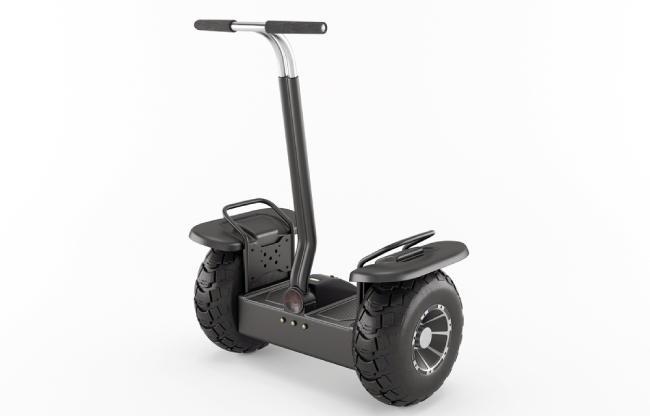
What are they?
Segways are electrically powered, two-wheel personal transporters built for multi-purpose use. Segways are controlled by moving a long central column topped with handlebars. They are twice the size of a hoverboard and controlled with your hands.
They’re large, heavy, and durable. Initially successful, they were designed to add a fashionable element of mobility to daily life.
Advantages
- Longer range
- Problems can be diagnosed via an app
- Fast urban travel
- Easy to use
Disadvantages
- Not portable
- Expensive
- Heavy
Hoverboard vs Segway – How They Differ

1. Size
Hoverboards
Most (if not all) hoverboards have a 28.5” x 8” footprint. Since their dimensions are constant, we distinguish hoverboards by tire diameter. We’ll go over that in a second.
Segways
Segway produced two consumer models: the i2 SE and the X2 SE.
The i2 SE is built for casual use and has a 25.5” x 25” footprint.
The X2 SE is built for off-road terrain. It features a wider base with a 26.5” x 33” footprint.
The Winner?
Hoverboards are the champ here. They’re generally wider but the lack of long handlebars makes them far more portable.
2. Tire Diameter
Hoverboards
Hoverboards come in three major tire sizes: 6.5”, 8” and 10”. 6.5” is a good start for children while 10” hoverboards maximize velocity and weight and so might be preferable for adults.
Segways
The casual i2 SE comes with 19” tires while the heavy-duty X2 SE packs 21” ATV-style tires. The i2’s relatively smooth tread is perfect for smooth, flat surfaces. The X2’s low-pressure and deep-grip treads are designed to handle heavy loads on harsh terrain.
The Winner?
It would depend on what you’re looking for. In terms of weight and portability, the hoverboard wins. If you want something that can go off-road, the X2’s tires are perfect.
3. Mobility
Hoverboards
Hoverboards are controlled purely with the feet. Angle your feet forwards to go forwards and bring them back to slow down or reverse. Move backward or forward so only that wheel will spin, allowing you to rotate in place.
Being hands-free, it’s easy to be thrown off if you hit an obstacle or are still getting used to throttling. However, hands-free is definitely aesthetic.
Segways
Segways feature an iconic central pillar with handlebars. Lean forward to go forward, lean back to brake, and pull the handlebars on either side to turn. Compared to a hoverboard, control feels more direct.
The Winner?
Hoverboards win when it comes to mobility. Considering their small footprint and fine control, they are more mobile than a Segway.
4. Riding Stability
Hoverboards
Sensitive control using just your feet is something to get used to. If you move too fast forward or back, you’ll most likely lose your footing. While moving, you’ll have to rely on your balance.
Segways
Handlebars and a heavy build make Segways incredibly stable. Even if you lose your balance or hit something on your path, you’ll always have something to hold on to.
The Winner?
Featuring handlebars and a heavy frame, Segways win when it comes to stability. Either way, wear a helmet!
5. Ease of Learning
Hoverboards
Hands-free will take some getting used to. You throttle, brake, and turn all with your feet and have to rely on your own balance to stay upright. Difficult at first, but once you’ve got it, you’ve got it.
Segways
Segways are straightforward. You lean to move and pull the handlebars in the direction you want to turn. Having something to hold on to means you’ve got a lot more risk-tolerance. It won’t take long to figure it out.
The Winner?
Segways win. They’re great for a beginner and couldn’t take longer than a few minutes to get used to.
6. Surface Handling
Hoverboards
Hoverboards are casual devices designed for indoor or urban use. Small tires with shallow treads offer good mobility and high speeds on the kind of smooth surfaces you’d expect to find in your own home or on the pavement outside. Urban tires are the opposite of what you should be taking off-road.
Segways
That being said, the Segway X2 is exactly what you should be taking off-road. 21” deep-tread tires like those you’d find on a quadbike can handle mud, gravel, inclines, and hills.
Conversely, the i2 has similar tires to a hoverboard. Like the hoverboard, the i2 is meant to be taken around the workplace or (large) home.
The Winner?
For rough terrain, the X2 wins hands down. It’s the only device designed to tackle those kinds of surfaces.
7. Operational Range
Hoverboards
Depending on the model, a hoverboard battery can last anywhere between 20 minutes to an hour. Nominally, they should get around 10 miles of range. Dependent on how they are being used and what sort of terrain they’re being taken on.
Segways
The X2 can manage up to 12 miles of range off-pavement. The i2, however, can go as far as 24 miles depending on how it’s used.
The Winner?
The Segways pack more energy in larger batteries. Both models outperform any hoverboard on range, with the i2 being a clear winner with up to 14 additional miles of range against a hoverboard.
8. Load Capacity
Hoverboards
The load-bearing capacity of hoverboards varies significantly depending on the wheel sizes.
- 6.5” models can handle up to 220lbs.
- 8.5” models can carry up to 265lbs
- The adult-sized 10” models can support up to 330lbs
Segways
The casual i2 has a recommended maximum of 257lbs while the off-road X2 has a 276lbs maximum weight limit.
The Winner?
On average, Segway’s i2 and X2 win when it comes to maximum weight. However, there are hoverboard models out there, albeit pricier, that’ll tolerate much more.
9. Model Variety
Hoverboards
Hoverboards are trendy devices and are produced by many different companies. Besides the range of models based on tire diameter (of which there are around 4-5), you’ll find plenty of suppliers.
Segways
Before production was discontinued and Segay was bought by Ninebot, there were only ever two models (which you can still find today), the casual i2 and the off-road X2.
The Winner?
Hoverboards see much more variety than Segways. Unlike the two Segway models, hoverboards come with several different tire diameters and are produced by many companies.
10. Bluetooth Connectivity
Hoverboards
Most hoverboards like the Hover-1 Helix Hoverboard support Bluetooth connections and have built-in speakers, through which you can play any media from your phone. Older models might not have Bluetooth and so won’t have these features.
Segways
Segways lack any Bluetooth connectivity. Unless you buy some speakers and strap them to your Segway, you won’t be able to play music from one.
The Winner?
For the tech-savvy user, the hoverboard is the clear preference. Most models these days come with Bluetooth support and built-in speakers.
11. Storing Your Device
Hoverboards
Hoverboards shouldn’t be stored in the cold, outside, or in a hot room. Heat and Lithium batteries aren’t a good combination. They should be stored in a dry, indoor, room-temperature location to avoid any damage to the body or battery.
Being light and small hoverboards are easy to store without taking up much space.
Segways
Segways are essentially the same as hoverboards in this respect. Lithium-ion batteries should be kept in cool, dry places away from moisture or temperature swings.
Segways have a much bigger footprint compared to hoverboards and so are more difficult to store without taking up a lot of space.
The Winner?
Recommendations for storing both devices are essentially the same. However, it is much easier to store a hoverboard owing to its smaller footprint and lighter weight.
12. Manoeuvrability
Hoverboards
Hoverboards are very mobile devices. Their pressure sensors have small dead-zones so they’re very sensitive. It takes a bit of getting used to, but they’re sure to be fast and maneuverable.
Segways
Segways are larger and bulkier. Their control mechanism makes for a more involved ride that might not be as fluid as a hoverboard. Still, they’re just as fast and they both share a zero turning circle.
The Winner?
Considering their size and weight, hoverboards are definitely a more maneuverable device compared to the Segway.
13. Device Safety
Hoverboards
Hoverboards don’t have many significant safety features. Besides self-balancing technology and reinforced batteries, these devices assume you wear the right safety gear before you use them.
Segways
The most obvious safety feature a Segway has is the handlebars. They self-balance and their batteries are designed to contain any overheating issues. While you learn how to use one, the handlebars should keep you from falling in most situations.
The Winner?
Segways have an obvious advantage in safety over hoverboards with their handlebar control mechanism. Keep a hold of the handlebars and like most wheeled devices, you’ll have far more control.
14. Portability
Hoverboards
Hoverboards are small and light. They can be carried by almost anyone and taken pretty much anywhere.
Segways
Segways are much heavier and have a much larger footprint. They’re suited to corporate leasing and transport by vehicle. You won’t fit them in a backpack!
The Winner?
Hoverboards are specifically designed for consumer-friendly leisure. They can be taken anywhere.
15. Easy to Park?
Hoverboards
Hoverboards take up very little space. You can leave them anywhere or just hold them if needed. But it’s not recommended that you leave your hoverboard unattended.
Segways
Segways shouldn’t be left unattended either. They’re slightly more complicated to park considering their footprint and you’ll always have to keep them in your line of sight in the interest of caution.
The Winner?
Comparatively, hoverboards are easier park. You can leave them anywhere reasonable. If you want to be extra cautious, you can simply keep it in your hands.
16. Device Regulations
Hoverboards
Hoverboards are permitted to ride on private land. You can’t ride them on roads or in public spaces.
Segways
Segways are generally only permitted to be used on private land or business spaces. However, tour guides and activity centers often lease them for public use.
The Winner?
Segways are slightly less regulated since they can be leased for public use, making them the winner in this case.
17. Weight Comparison
Hoverboards
Most hoverboards weigh around 25lbs. Lighter children’s models weigh around 17.5lbs, but you can get up to 35lbs models
Segways
Segway weights are:
- 105lbs for the i2
- 120lbs for the X2
The Winner?
It’s obvious that hoverboards are much, much lighter than either of the Segway models.
18. Cost
Hoverboards
For a brand new hoverboard, you’ll pay between $180 and $330 depending on wheel diameter, model age and accessories.
Segways
- i2 SE: $7315
- X2 SE: $7838
- X2 SE Patroller: $8490
The Winner?
Segways, meant for more professional use, are far more expensive than hoverboards. For the price-sensitive skater, hoverboards win on price.
Are There Any Similarities?
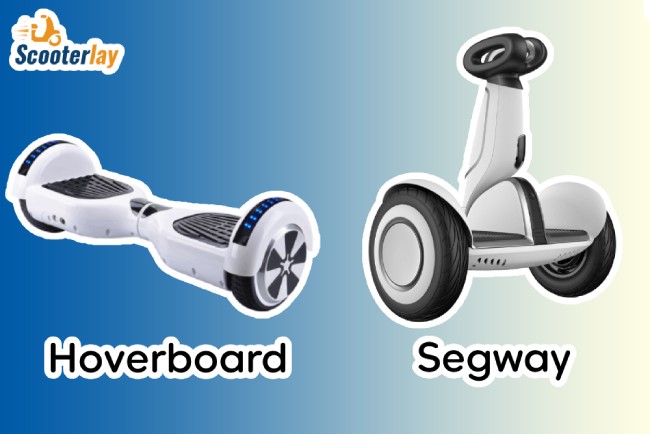
1. Motors
Both devices are powered by a pair of brushless DC motors, found in both wheels. This allows each wheel to be powered independently of the other. This is necessary for zero turning circles and fine control.
2. Locking
If you want to be extra safe you can buy a key FOB for your hoverboard. These keys let you wirelessly lock and unlock your hoverboard much like you would a car.
Segways came with InfoKeys, giving you basic information on your Segway and allowing you to wirelessly lock and unlock the device when leaving them unattended.
3. Lighting
Most hoverboard models come with LED lighting in the platform that can be customized through a connected smartphone.
Segways came with a reflector and “gliding lights”, which make the user more visible in low-light conditions. There are also headlights that can be bought off secondary markets, which you can easily fit to your Segway.
4. Water Resistance
Both Segways and hoverboards are rated IP54 water-resistant. They won’t explode in the rain, but don’t take through a flood.
5. Control
Segways and hoverboards are self-balancing scooters. Lean where you want to go and let the wheels do the work.
6. Feel
Both devices feel fluid and natural to use. They move as you move so the kinetics are, once you’ve gotten used to them, very intuitive. The only other difference is hands-on and hands-free.
Which Should You Get?
Which one you ultimately buy depends on the use you have in mind. Segways are larger, more involved devices designed for professional and public use. It’s not inaccurate to picture mall cops and businessmen when you hear Segway.
On the other hand, hoverboards saw their debut as a Christmas gift craze. They’re low-cost, casual devices marketed to children. If you want a fun and trendy method of zooming around private land, hoverboards are for you.
FAQs
1. What’s the minimum age requirement for hoverboards?
Ans. It isn’t recommended to use a hoverboard under the age of 13.
2. How long do hoverboards take to charge?
Ans. Hoverboards can be fully charged in around 60 to 90 minutes.
3. Are there any hoverboards that aren’t safe?
Ans. It might be wise to avoid Go Wheels, iLive products, Sonic Smart wheels, and Tech Drift.
4. What’s the minimum age requirement for Segways?
Ans. It’s advised children of no younger than 13 years old ride a Segway.
5. Can I just buy a Segway and ride around on my own?
Ans. On private property, yes. You can only ride a Segway in public as part of a guided tour.
6. What is the InfoKey?
Ans. The InfoKey is your key and dashboard for your Segway. It’ll be programmed to your Segway so you can lock and unlock it.
7. Where can I find my Segway’s serial number?
Ans. You’ll find the 12-digit code on the underside of the right floor mat.




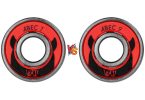
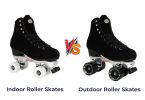



Leave a Comment